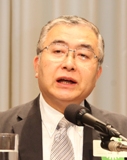What Japan should do in the Competition for Natural Resources
July 14, 2010
Mr. Akio Shibata
Chief Representative, Marubeni Research Institute
 ��Studies on the shifting patterns of the 10-year-average world economic growth rates show that the decades are divided into two eras, an era with 5% growth rate and another era with 3% growth rate. My study on resource markets since the 1980s has proved that the world economy starts to improve by achieving the growth rate of over 3%. I predict the world economy will regain the 5% growth rate sometime during the 2000s.
��Studies on the shifting patterns of the 10-year-average world economic growth rates show that the decades are divided into two eras, an era with 5% growth rate and another era with 3% growth rate. My study on resource markets since the 1980s has proved that the world economy starts to improve by achieving the growth rate of over 3%. I predict the world economy will regain the 5% growth rate sometime during the 2000s.
��Japan and West Germany propelled economic growth in the 1950s and 1960s. Japan achieved a real GDP growth rate of 9.3% up to 1973, when the first oil crisis occurred. Oil prices started to rise, triggered by the Yom Kippur War in 1973. Crude oil prices surged from 2 dollars to 11 dollars per barrel. In the 1980s, the prices soared by 20 times up to 40 dollars.
��Many developed nations implemented energy and resource-saving measures, while intensifying their industrial structures. Besides, the worldwide development boom for resources triggered sharp decline in its values during the 1980s and 1990s. Thanks to the low-priced resources, countries like China promoted industrialization and achieved soaring economic growth, leading to sharp rise in demands for resources and boost in their values. Crude oil price almost reached 150 dollars in July, 2008. The Lehman��s Shock, on September 15th 2008, plunged the price down to nearly 30 dollars per barrel.
��Now, let me give you three perspectives on the world after the Lehman��s Shock. Firstly, analysis on the world and Japanese economies based on business cycles show fast economic recovery exceeding expectations. The Lehman��s Shock, said to be the worst crisis in 100 years, literally froze the world economy. Yet, it has started to recover rapidly since April-June, 2009. This was because governments jointly proceeded towards aggressive monetary and financial policies, thus avoiding the world economy sliding into a great depression.
��Secondly, the power shift or overall structural transformation in the world economy, especially after the Lehman��s Shock, has stimulated demands for resources and eventually pushed up their prices. Industrial nations, with a total population of 800 million, had once propelled the world economy through exclusive consumption of resources in the international market up to the 1990s. As we entered the 2000s, the so-called ��BRICs�� emerging nations, with massive populations, promoted industrialization for sustainable economic growth, thus pushing up resource prices. For example, China with its 1.3 billion population is forecast to keep its economic growth rate of 8% for the coming 15 years before becoming a truly industrialized nation, only achievable through massive resource consumptions. Power shift in the world economy has become an obstacle to regulate resource prices in the international market, thus resulting in soaring prices or setting much higher standards for reasonable prices.
��This brings me to my third point, which I call ��change in the balance point for prices.�� Prices of major resources (coal, iron ore, crude oil and natural rubber) shifted in the same pattern over the past 50 years. Prices stabilized at low-levels until the 1960s, followed by increase in the 1970s and ��change in the balance point for prices,�� again stabilized during the 1980s and 1990s, and then recorded a sharp rise in the 2000s. What we are experiencing today is similar to what we went through during the 1970s with the oil crisis. Yet, we face two different crises today proceeding at an irreversible pace, one being ��resource depletion�� and the other being ��global warming.�� To tackle these crises, I believe, ��concentration�� will be the key. We must search beyond the concentrated, massive, quality and easy-to-access resources, which are already half extracted, and try to tap and process non-concentrated resources, including tar sand in Canada or deepwater oilfield in the Gulf of Mexico, to meet ever growing resource demands.
��The year 2030 is said to be the ��point of no return�� for our mother earth. We must advance the switching from underground resources to solar-system resources, including solar energy generation, secondary battery and electric vehicles.
��Now, what should Japan do? Let me point out that we should understand that soaring resource prices today are caused by ��change in the balance point for prices�� and should not misinterpret that they are just a temporary phenomenon or outcome of the money game. The market is warning us that we must take immediate measures against ��resource depletion�� and ��global warming.�� Price rise will activate market for solar batteries or secondary batteries. Time has come to move beyond the 20th century growth model supported by underground resources, and seek new growth markets based on the 21st century growth model that utilizes the solar-system resources. Time is pressing. I am convinced a big business chance is approaching for the Japanese companies to implement new growth models based on solar-systems.